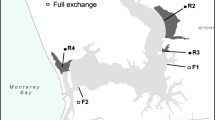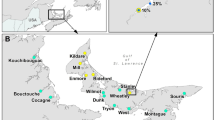Abstract
Hypoxia, periods of reduced dissolved oxygen concentrations, has been observed not only in the Chesapeake Bay but also in the deeper waters of the Virginia estuaries that are tributaries to the Chesapeake Bay. When water temperature exceeded 20°C, minimum oxygen concentrations were observed to be <50% of saturation concentrations in 75%, 50% and 2% of the surveys in the estuaries of the Rappahannock, York and James rivers, respectively. The observation that hypoxia rarely occurred in the James River is surprising, given the fact that it receives the greatest amount of wastewater. Analysis of the oxygen budgets in these estuaries indicates that the variations in the frequency, duration, and severity of hypoxia are related to the net movement of bottom waters. This relationship has significant implications for the management of water quality and marine fisheries.
Similar content being viewed by others
Literature Cited
Boynton, W. R., W. M. Kemp, andC. G. Osborne. 1980. Nutrient fluxes across the sediment-water interface in the turbid zone of a coastal plain estuary, p. 93–109.In V. S. Kennedy (ed.), Estuarine Perspectives. Academic Press, New York.
Brooks, T. J. 1983a. Slack water data report temperature, salinity and dissolved oxygen—James River. Va. Inst. of Mar. Sci. Data Rep. 12. VIMS, Gloucester Point, Virginia.
Brooks, T. J. 1983b. Slack water data report, temperature, salinity and dissolved oxygen—Rappahannock River. Va. Inst. of Mar. Sci. Data Rep. 18. VIMS, Gloucester Point, Virginia.
Brooks, T. J. 1983c. Slack water data report, temperature, salinity and dissolved oxygen—York River. Va. Inst. of Mar. Sci. Data Rep. 19. VIMS, Gloucester Point, Virginia.
Cerco, C. F. 1985. Sediment-water column exchanges of nutrients and oxygen in the tidal James and Appomattox rivers. National Tech. Information Service, PB85-242915 XAB. 110 p.
D’Elia, C. F., K. L. Webb, andR. L. Wetzel. 1981. Time varying hydrodynamics and water quality in an estuary, p. 597–606.In B. J. Neilson and L. E. Cronin (eds.), Estuaries and Nutrients. The Humana Press, Clifton, New Jersey.
Flemer, D. A., G. B. Mackierman, W. Nehlsen, andV. K. Tippie. 1983. Chesapeake Bay: A Profile of Environmental Change. U.S. Environ. Protection Agency, Washington, D.C. 199 p.
Haas, L. W. 1977. The effect of the spring-neap tidal cycle on the vertical salinity structure of the James, York and Rappahannock rivers, Virginia, USA.Estuarine Coastal Mar. Sci. 5:485–496.
Hansen, D. V., andM. Rattray, Jr. 1966. New dimensions in estuary classification.Limnol. Oceanogr. 11:319–326.
HydroQual, Inc. 1986. Water quality analysis of the James and Appomattox rivers. Rep. to the Richmond Regional Planning District Commission, Richmond, Virginia. 150 p.
Newcombe, C. L., andW. A. Horne. 1938. Oxygen poor waters of the Chesapeake Bay.Science 88:80–81.
Officer, C. B., R. B. Biggs, J. L. Taft, L. E. Cronin, M. A. Tyler, andW. R. Boyton. 1984. Chesapeake Bay anoxia: Origin, development and significance.Science 223:22–27.
Phoel, W., K. L. Webb, andC. F. D’Elia. 1981. Inorganic nitrogen regeneration and total oxygen consumption by the sediment at the mouth of the York River, Virginia, p. 607–619.In B. J. Neilson and L. E. Cronin (eds.), Estuaries and Nutrients. The Humana Press, Clifton, New Jersey.
Pritchard, D. W. 1952. Salinity distribution and circulation in the Chesapeake Bay estuarine system.J. Mar. Res. 11:106–123.
Pritchard, D. W. 1967. Observations of circulation in coastal plain estuaries, p. 37–44.In G. H. Lauff (ed.), Estuaries. Publication No 83. American Association for the Advancement of Science, Washington, D.C.
Schroeder, W. W. (convener) 1985. The occurrence of hypoxic and anoxic conditions in estuaries and coastal environments. Abstract for the 8th Biennial Estuarine Research Conference.Estuaries 8(2B):43A-47A.
Seliger, H. H., J. A. Boggs, andJ. A. Biggley. 1985. Catastrophic anoxia in the Chesapeake Bay in 1984.Science 228:70–73.
Thomann, R. V. 1971. System Analysis and Water Quality Management. Environ. Res. and Application, Inc. New York. 286 p.
Webb, K. L., andC. F. D’Elia. 1980. Nutrient and oxygen redistribution during a spring-neap tidal cycle in a temperate estuary.Science 207:983–985.
Author information
Authors and Affiliations
Additional information
Contribution number 1424 of the Virginia Institute of Marine Science, College of William and Mary.
Rights and permissions
About this article
Cite this article
Kuo, A.Y., Neilson, B.J. Hypoxia and salinity in Virginia estuaries. Estuaries 10, 277–283 (1987). https://doi.org/10.2307/1351884
Received:
Accepted:
Issue Date:
DOI: https://doi.org/10.2307/1351884




